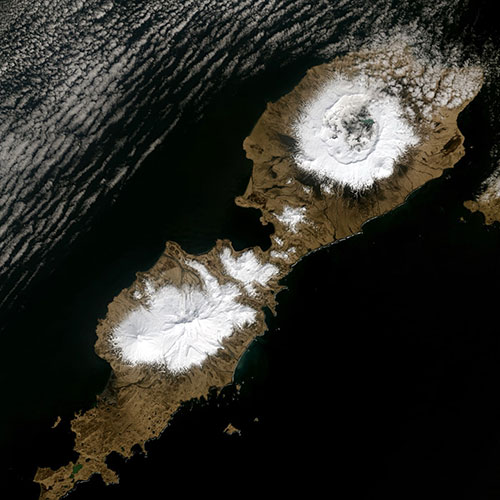

















 Contact Contact 
 Webmail
Letters Webmail
Letters
 News Tips News Tips
 Copyright Info Copyright Info
 Archives Archives
Quick News
Search
 Alaska Alaska
 Ketchikan Ketchikan
 SE Alaska SE Alaska
Columns
- Articles
 Dave Kiffer Dave Kiffer
 Money Matters Money Matters
Historical
Ketchikan
 June Allen June Allen
 Dave
Kiffer Dave
Kiffer
 Louise
B. Harrington Louise
B. Harrington
Sports
 Ketchikan Links Ketchikan Links
Public Records
 FAA Accident Reports FAA Accident Reports
 NTSB
Accident Reports NTSB
Accident Reports
 Court Calendar Court Calendar
 Recent Filings & Case Dispositions Recent Filings & Case Dispositions
 Court Records Search Court Records Search
 Sex Offender Reg. Sex Offender Reg.
 Public Notices Public Notices
 Alaska Recall Alerts Alaska Recall Alerts
 Recalls.gov Recalls.gov
 AST Daily Dispatch AST Daily Dispatch
 KTN
Police Reports KTN
Police Reports
 Juneau Police Reports Juneau Police Reports
Weather,
Webcams
 Today's
Forecast Today's
Forecast
 KTN
Weather Data KTN
Weather Data
 AK
Weather Map AK
Weather Map
 AK Weathercams AK Weathercams
 AK Earthquakes AK Earthquakes

|
|

Monday
June 22, 2020
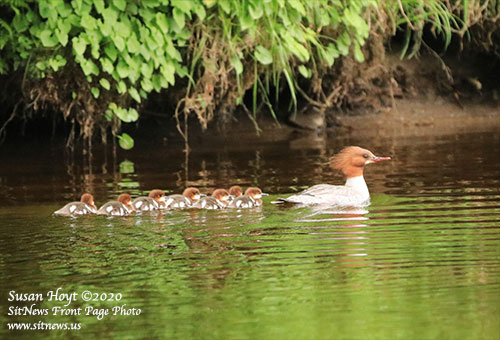
Ward Lake: Merganzer & Chicks
Front Page Photo By SUSAN HOYT ©2020
To have your photo featured on the front page,
email your photo(s) to editor@sitnews.us |
|
Ketchikan Historical: A South Tongass Airport? Not really, but a local pilot did land there once By DAVE KIFFER - Before the middle part of the 20th Century, Southeast Alaska was a generally unhospitable place for land planes.
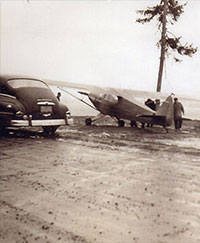
Herman Ludwigsen landed his Piper plane at Mountain Point in 1953.
Photo courtesy Herman Ludwigsen © |
Most planes that transited the Inside Passage had floats, allowing them to land on any suitable waterway, such as lakes or the saltwater near the communities. There were some large beaches in the region that were big and flat enough for small wheeled planes to land on, but this was considered an emergency option because those beaches were not located near any of the region's far flung larger communities.
In the 1930s, flat land at the mouth of the Mendenhall River was turned into a small airport for the Juneau area. During World War II, military airports were built in Sitka and Ketchikan (Annette Island) to support the war effort and those eventually became civilian airports after the war.
Ketchikan's airport was somewhat problematic for the community, being located some 20 miles away from Ketchikan on an entirely separate island. While larger wheeled planes and early jets could land on Annette Island, passengers to Ketchikan were still required to get into smaller float planes and amphibians if they wanted to continue to on the First City.
In the early aviation years, there were occasional reports of wheeled planes landing on beaches near Ketchikan, particularly on the north end of town, but these were rare occurrences.
Therefore, it was big news, and worth of stories in both Ketchikan's daily news papers, when local pilot Herman Ludwigsen decided to attempt to land a wheeled plane on the South Tongass Highway near Mountain Point in 1953.
Ludwigsen, a local fisherman and pilot, had completed a tour of duty with the Army in Southwestern Alaska. He learned how to fly before leaving Ketchikan in the late 1940s and had spent his enlistment flying for the Army in the Yukon-Kuskokwim area.
His tour of duty ended in 1952 and he signed up four years with the Army reserve rather than re-up his regular Army duty. His father-in-law, Max Lieb, bought Ludwigsen a Piper Supercruiser on wheels. Ludwigsen decided to return to Ketchikan to continue his aviation career.
As his Army time wound down, Ludwigsen had been planning to get an airplane and return to Ketchikan where he had learned to fly in the mid 1940s. He had his eye on a semi-derelict plane in Bethel.
"The plane was rough," he said. "The fabric was all ripped up, it had been sitting just off the dirt strip for years. It was a sad wreck. I could see it every time I went for a walk on the side of the runway and started asking questions."
The purchase price was $1,500, or $14,500 in 2020 dollars. And that was only the beginning, as Ludwigsen then spent four months rehabbing the Piper from the ground up.
"I rebuilt the whole thing," he said. "Rebuilt the engine, refabricated the fuselage. Your refabric jobs are tough, you have to stretch them tight, make sure all the joints, the connections, the tubings are not rusted or corroded and fall apart on you. It was just a matter of doing the damn thing right."
When the plane was ready to fly, Ludwigsen was ready to go to Anchorage to get his Army discharge and then go home to Ketchikan, a distance of more than 1,100 miles, the longest flight distance he had flown up to that point.
"Flew the whole way without a radio," he said. "When you do that you fly by the airport and let them know you need to make a landing, you make one pass on the downwind run and you blink your running lights and he sees you and he gives the red light, meaning don't land or go around. Or gives you a green light, okay, come in to land. That was years ago, it happened that way because you don't have much communication."
Ludwigsen planned to fly first to McGrath, then Anchorage, then Yakutat, Juneau and finally Ketchikan.
"Anyone with any sense wouldn't have left," he said. "It was late November. I was on wheels, no skies, no radio, never having flown there before. (I was) just some dumb guy who took it and went. I can't believe it (now)."
After flying past Aniak, Sleetmute, and Crooked Creek, he got into trouble.
"All hell broke loose," he said. "A big snow storm. (Later) looking at my charts, I wouldn't have made it anyway. I was flying ground contact. So I turned back and landed at Crooked Creek. I overshot the runway because it was snowing heavily. Once I got on the ground I turned back."
He said the local school teacher in Crooked Creek came out to meet him.
"He looked at me and smiled," Ludwigsen said. "He said 'did you see that all the first 300 or 400 feet (of the landing) was all six inch stumps? You're very lucky." - More...
Monday PM - June 22, 2020
|
|
Fish Factor:
Cod crash relief payments slowed; Pink salmon funds, finally; Signs of salmon trouble
By LAINE WELCH
- Unexpected upheavals stemming from the coronavirus have slowed the process of getting relief payments into the hands of fishermen and communities hurt by the 2018 Gulf of Alaska cod crash.
In late February, the Secretary of Commerce cut loose $24,416,440 for affected stakeholders. Then in late March, Alaska Dept. of Fish and Game Commissioner Doug Vincent-Lang proposed a written timeline for developing a distribution plan and also called for input from communities and fishing groups.
A draft of the initial plan was intended to compile stakeholder comments in April, be revised in May, and go out for a second round of public input in June and July. But that timeframe was derailed a bit by Covid.
Now, the state is “aiming” to get the draft distribution plan out for the first round of stakeholder and public comments by the end of June, according to Rick Green, assistant to the ADF&G commissioner.
There will be a month for comments, Green said, and after resulting revisions the plan will be sent out for more feedback, likely in late August. Then it will be reviewed, finalized and sent to NOAA Fisheries for approval, hopefully in September.
ADF&G will work with the Pacific States Marine Fisheries Commission to get the distribution done as quickly as possible, he added.
The disaster funds will assist fishing communities affected by the cod crash by going to fishermen, subsistence users, shore-side businesses and infrastructure. Money also can be used for research activities to help improve the fishing ecosystem and environment.
Pink salmon funds, finally:
Hopefully, the process for cod losses will move more quickly than they payout for the 2016 pink salmon failure in which over $56 million in federal relief funds finally made it to fishermen, processors and communities in just the past few months.
It includes Kodiak, Prince William Sound, Chignik, Lower Cook Inlet, South Alaska Peninsula, Southeast Alaska, and Yakutat.
Congress ok’d the money in 2017, but the authorization sat on bureaucrats’ desks in DC for over two years. Then it was discovered that the ways in which the payouts to pink salmon fishermen were calculated was badly flawed, stalling the process even further.
Salmon permit holders, who split the biggest share at nearly $32 million, were finally able to apply last October to the Pacific States Marine Fisheries Commission which administers the funds.
There were 1,318 permit holders who applied and 905 received payments, according to Karla Bush, ADF&G Extended Jurisdiction Program Manager.
Funds allocated to permit holders were calculated based on the loss of pink salmon exvessel (dockside) value for each management area as compared to its five even year fishery average value. The disaster funds were distributed based on an area’s fishery value equal to 70.56% of the respective five even year average dockside value.
That resulted in minimum payments of $139,200 for 464 permit holders in Southeast Alaska, $22,800 for 76 from Yakutat, $7,800 for 26 Lower Cook Inlet salmon permit holders, $97,500 for 325 at Prince William Sound, $71,400 for 238 Kodiak fishermen, $31,500 for 105 recipients at the South Alaska Peninsula and $18,900 for 63 salmon permit holders at Chignik.
Of the 2,233 crew members who applied for disaster funds 1,554 were eligible for payouts.
According to a PSMFC fact sheet , payments to crew were deducted from a permit holder’s loss based on crew shares. For example, if a permit holder had a loss of $25,000, a crew member listed as earning a 10% share would be eligible for a payment of $2,500.
A total of 38 Alaska salmon processors applied for the funds and 30 were eligible, Bush said. They split nearly $18 million in relief funds, of which 15% of each processor’s total were deducted and distributed equally to eligible processing workers.
In addition, $2.4 million was earmarked for Alaska municipalities affected by the pink crash and nearly $4 million for pink salmon research.
Of that, $450,000 went to Kodiak’s Kitoi Bay Hatchery for its Saltwater Marking Sampling project. The Southeast Alaska Coastal Monitoring Survey was set to get $680,000 to help with pink salmon forecasting. And $2.5 million went to the Alaska Hatchery Research Project that since 2010 has studied interactions of hatchery and wild salmon in Prince William Sound and Southeast.
U.S. regions that face fisheries disasters will no longer endure the years of awaiting funds if Congress passes a bipartisan bill introduced in January called the Fishery Failures: Urgently Needed Disaster Declarations Act (Fishery FUNDD Act) that would improve the federal process and set a strict timeline for payout of funds. - More...
Monday PM - June 22, 2020
|
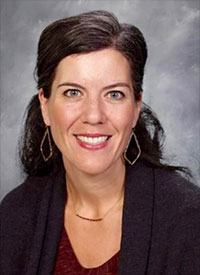
Sarah Campbell, an English teacher at Ketchikan High School, Named a Top Inspiring Teacher in Alaska |
Ketchikan: Sarah Campbell Named a Top Inspiring Teacher in Alaska and Honored With $10,000 from the National University System – Sanford Teacher Award - In recognition of inspirational teaching nationwide, Sarah Campbell, an English teacher at Ketchikan High School in Ketchikan has been named a recipient of the National University System-Sanford Teacher Award for Alaska on a surprise Zoom announcement.
During a year of unprecedented challenges for teachers nationwide, the Sanford Teacher Award honors the top teacher in each state and the District of Columbia with $10,000 for supporting student development and achievement in inspirational and harmonious ways. The award was established in the name of philanthropist T. Denny Sanford, who is committed to supporting inspiring teaching nationwide through PreK-12 programs focused on developing the social and emotional (SEL) skills of young people. Each teacher recipient is now eligible to be named the national winner of the Sanford Teacher Award, which comes with a total award of $50,000 and will be announced at a future date.
Campbell has let her life experiences inform her teaching, adding a specific sensitivity and proximity to her lessons plan. She was selected in 2013 to participate in the National Consortium for Teaching about Asia (NCTA) Peace Study Tour to Japan. Seeing Hiroshima and the damage and destruction surrounding this historical event, she found a new appreciation for empathy as a teaching tool. Having her students read about the Holocaust, the atomic bomb, and Hiroshima, helps inform them, emotionally engage with the topics, and use empathy to guide their learning. Focusing on emotional development also expands students’ passion and purpose within student learning. - More...
Monday PM - June 22, 2020
|
|
Alaska: Man of Salmon; An Interview with Triston Chaney By BJORN DIHLE - Triston Chaney, a Yupik and Athabaskan resident of Dillingham, began fishing on his grandpa’s gillnetter in Bristol Bay when he was nine years old. He was too young to be on the deck picking salmon from the net, so his grandpa had him count fish as they came aboard. The two have been fishing together every season since.
Chaney is now 21 years old, and commercial fishing is only one aspect of his relationship with salmon. His dad taught him how to fly-fish when he was young, and he fell in love with the sport early in high school. Before the commercial fishing season, Chaney and his family put out a beach set-net to gather food for the year to come. First, they target kings and, then, sockeyes. Triston’s grandma splits the fish and the family helps hang them in the smokehouse.
“When the salmon are running, we can catch all we want pretty quickly. We keep what we need and then share the rest with some of the old timers and people not as fortunate as us,” Chaney said over the phone when he was taking a break from mending nets and getting his grandpa’s boat ready for the 2020 sockeye season.
Sockeyes are commonly called “reds” due to the color their skin turn shortly before they spawn. The flesh of sockeye is also the reddest of all species of salmon—and its high oil content and delicious taste makes it many folks’ favorite fish to eat. More than that, though, sockeye are a living metaphor telling of a connection to the people of Bristol Bay that goes back beyond memory. Sometimes, when the sockeye spawn in the clear water of lakes, rivers and streams, they look like blood moving through veins made of water.
“Everything revolves around fish here,” Chaney said.
Chaney is tied to his family and the land in a way that is becoming rarer in our ever increasingly industrialized world. His first memories are of hunting spruce chickens (spruce grouse) with his grandpa—from his beginning he was harvesting wild food that he would share with family and others in his community. During the fall and winter, he studies Diesel/Heavy Duty Mechanics at the University of Alaska Southeast. After he graduates, he plans to live in Bristol Bay year-round and do what he loves most: fish. Chaney’s favorite fish to eat is king salmon, especially the smoked bellies, though sockeye comes in a close second. His favorite fish overall is the grayling. His favorite fish to catch is a rainbow trout while using a mouse fly.
“A rainbow will demolish a mouse fly,” Chaney said, reflecting on his love of fly fishing. “So much goes into fly fishing. It’s all about the intricacies. The choices. The cast. The fight is better on a fly rod.” - More...
Monday PM - June 22, 2020 |
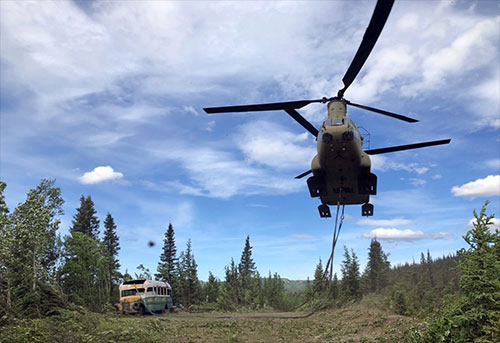
National Guard airlifts 'Into the Wild' bus
out of Alaska wilderness
By Sgt. Seth LaCount
Alaska Army National Guard Soldiers assigned to 1st Battalion, 207th Aviation Regiment execute an extraction mission via a CH-47 Chinook helicopter over Healy, Alaska, June 18, 2020. As part of a combined effort with the Department of Natural Resources, the Guardsmen rigged and airlifted “Bus 142”,, an historic icon from book and film, “Into the Wild”, out of its location on Stampede Road in light of public safety concerns. The bus will be stored at a secure site while the DNR considers all options and alternatives for its permanent disposition.
Photo Credit: Alaska National Guard |
|
Alaska: National Guard airlifts 'Into the Wild' bus out of Alaska wilderness By Sgt. Seth LaCount - A 1940s-era bus featured in the book and movie, "Into the Wild," was extracted from the Stampede Trail west of the Teklanika River by the Alaska National Guard June 18.
In a coordinated effort with the Department of Natural Resources, 12 Alaska Army National Guardsmen assigned to 1st Battalion, 207th Aviation Regiment, airlifted the abandoned bus to a secure site.
"After studying the issue closely, weighing many factors and considering a variety of alternatives, we decided it was best to remove the bus from its location on the Stampede Trail," said Corri A. Feige, commissioner for the Department of Natural Resources. "We're fortunate the Alaska Army National Guard could do the job as a training mission to practice airlifting vehicles, at no cost to the public or additional cost to the state."
The abandoned vehicle that sat 25 miles west of the Parks Highway near Healy, known as "Bus 142," or the "Magic Bus," was popularized by John Krakauer's 1996 book "Into the Wild," and Sean Penn's film adaptation in 2007 that chronicles the story of 24-year-old adventurer Chris McCandless, who spent the summer in the bus in 1992 and died of starvation after 114-days.
Numerous travelers have sought to reach the bus by retracing McCandless' steps, and many have come to harm or required search-and-rescue services while hiking in harsh weather or crossing the rain- and meltwater-swollen Teklanika or Savage rivers.
There were 15 bus-related search-and-rescue operations by the state between 2009 and 2017, according to DNR reports. In February, Alaska State Troopers rescued five Italian hikers, one of whom suffered severe frostbite. Travelers from Switzerland and Belarus drowned in 2010 and 2019, prompting public outcry – particularly among Alaskans – to reduce or eliminate the hazard.
"We encourage people to enjoy Alaska's wild areas safely, and we understand the hold this bus has had on the popular imagination," said Feige. "However, this is an abandoned and deteriorating vehicle that was requiring dangerous and costly rescue efforts, but more importantly, was costing some visitors their lives. I'm glad we found a safe, respectful and economical solution to this situation."
Under the oversight of the DNR, the 1-207th AVN pilots, flight engineers, crew chiefs and mechanics arrived via a UH-60 Black Hawk helicopter to clear vegetation and obstacles and ensure a safe rigging operation. Holes were cut in the roof and floor of the vehicle so dual point chain kits could be secured to the bus's frame.
Employees from the DNR and the Department of Transportation and Public Facilities removed boulders that had blocked the surface entrance from Stampede road to the materials site, which served as an interim staging point.
"This was a tremendous training opportunity for our heavy lift unit and a great way to lend a helping hand to our partners in the DNR and Alaskans everywhere," said Maj. Zachary Miller, an executive officer with 1-207th AVN and primary pilot for the extraction. - More...
Monday PM - June 22, 2020
|
|
Alaska: Eruption of Alaska’s Okmok volcano linked to mysterious period of extreme cold in ancient Rome - An international team of scientists and historians has found evidence connecting an unexplained period of extreme cold in ancient Rome with an unlikely source: a massive eruption of Alaska’s Okmok volcano, located on the opposite side of the Earth. Around the time of Julius Caesar’s death in 44 BCE, written sources describe a period of unusually cold climate, crop failures, famine, disease, and unrest in the Mediterranean Region – impacts that ultimately contributed to the downfall of the Roman Republic and Ptolemaic Kingdom of Egypt. Historians have long suspected a volcano to be the cause, but have been unable to pinpoint where or when such an eruption had occurred, or how severe it was.
In a new study published this week in Proceedings of the National Academy of Sciences (PNAS), a research team led by Joe McConnell, Ph.D. of the Desert Research Institute in Reno, Nev. uses an analysis of tephra (volcanic ash) found in Arctic ice cores to link the period of unexplained extreme climate in the Mediterranean with the caldera-forming eruption of Alaska’s Okmok volcano in 43 BCE.
“To find evidence that a volcano on the other side of the earth erupted and effectively contributed to the demise of the Romans and the Egyptians and the rise of the Roman Empire is fascinating,” McConnell said. “It certainly shows how interconnected the world was even 2,000 years ago.”
The discovery was initially made last year in DRI’s Ice Core Laboratory, when McConnell and Swiss researcher Michael Sigl, Ph.D. from the Oeschger Centre for Climate Change Research at the University of Bern happened upon an unusually well-preserved layer of tephra in an ice core sample and decided to investigate.
New measurements were made on ice cores from Greenland and Russia, some of which were drilled in the 1990s and archived in the U.S., Denmark, and Germany. Using these and earlier measurements, they were able to clearly delineate two distinct eruptions – a powerful but short-lived, relatively localized event in early 45 BCE, and a much larger and more widespread event in early 43 BCE with volcanic fallout that lasted more than two years in all the ice core records.
The researchers then conducted a geochemical analysis of the tephra samples from the second eruption found in the ice, matching the tiny shards with those of the Okmok II eruption in Alaska – one of the largest eruptions of the past 2,500 years.
“The tephra match doesn’t get any better,” said tephra specialist Gill Plunkett, Ph.D. from Queen’s University Belfast. “We compared the chemical fingerprint of the tephra found in the ice with tephra from volcanoes thought to have erupted about that time and it was very clear that the source of the 43 BCE fallout in the ice was the Okmok II eruption.”
Working with colleagues from the U.K., Switzerland, Ireland, Germany, Denmark, Alaska, and Yale University in Connecticut, the team of historians and scientists gathered supporting evidence from around the globe, including tree-ring-based climate records from Scandinavia, Austria and California’s White Mountains, and climate records from a speleothem (cave formations) from Shihua Cave in northeast China. They then used Earth system modeling to develop a more complete understanding of the timing and magnitude of volcanism during this period and its effects on climate and history.
According to their findings, the two years following the Okmok II eruption were some of the coldest in the Northern Hemisphere in the past 2,500 years, and the decade that followed was the fourth coldest. Climate models suggest that seasonally averaged temperatures may have been as much as 7oC (13oF) below normal during the summer and autumn that followed the 43 BCE eruption of Okmok, with summer precipitation of 50 to 120 percent above normal throughout Southern Europe, and autumn precipitation reaching as high as 400 percent of normal. - More...
Monday PM - June 22, 2020
|
Analysis: The Supreme Court decision to grant protections to LGBT workers is an important expansion of the Civil Rights Act By JULIE MANNING MAGID - No federal law barring discrimination against LGBT workers in hiring, promoting and firing existed in this country until last week.
Although some may have believed LGBT individuals were protected from discrimination following the Supreme Court’s Obergefell v. Hodges decision that found the fundamental right to marry is guaranteed to same-sex couples, this was not the case.
I’m a professor of business law, and I believe the Bostock v. Clayton County, Georgia decision issued on June 16 could be one of the most important in the Civil Rights Act’s history.
On the basis of sex
Title VII of the Civil Rights Act made it illegal for employers to discriminate based on an individual’s race, color, religion, sex or national origin.
In October 2019, the U.S. Supreme Court heard three cases that raised the question of whether the act prevents discrimination toward LGBT workers on the basis of sex.
Two of the cases were brought by men who allegedly lost their jobs because they are gay. The third case addressed transgender discrimination in the workplace. All three cases were consolidated and decided by Bostock v. Clayton County, Georgia. - More...
Monday PM - June 22, 2020
Analysis: Devil in the detail of SCOTUS ruling on workplace bias puts LGBTQ rights and religious freedom on collision course By KELSY BURKE AND EMILY KAZYAK - The Supreme Court’s landmark ruling extending workplace discrimination protection to cover sexual orientation and gender identity was cheered by LGBTQ people and allies. Indeed, the June 15 decision represents a big win in the fight for LGBTQ equality.
But buried towards the end of a 33-page majority opinion written by conservative stalwart Justice Neil Gorsuch is a sober warning that those celebrating the decision might have initially missed.
In his reading, the religious beliefs of an employer may “supersede” the Title VII protections now being extended to the LGBTQ community in its resolution of Bostock v. Clayton County. It is an issue that courts will likely have to decide on a case-by-case basis in the future. But Gorsuch notably referred to the Religious Freedom Restoration Act, passed by Congress in 1993 to protect an individual’s practice of their faith, as a “super statute” and emphasizes the court’s mandate to uphold “the promise of the free exercise of religion enshrined in our Constitution.”
Religious rights
In short, Gorsuch’s caveat means that discrimination against LGBTQ people in the workplace may be far from over. In fact, discrimination on the basis of sexual orientation and gender identity may even be legally protected under the basis of protecting the free exercise of religion. - More...
Monday PM - June 22, 2020
|

Political Cartoon: Canceled Statues
By Gary McCoy ©2020, Shiloh, IL
Distributed to paid subscribers for publication by Cagle Cartoons, Inc. |
 |
The Office of Professional Standards Investigates Allegations of Trooper Misconduct and Provides Accountability; Members of the public are encouraged to make their concerns known By Investigator Ben Evans, DPS’s Office of Professional Standards - So many questions have circulated across the nation and here in Alaska regarding training standards, policies and procedures that law enforcement agencies have in place. As the lead investigator for allegations of officer misconduct at the Department of Public Safety, I was shocked by the video, showing Mr. George Floyd’s treatment at the hands of the four former Minneapolis Police officers, that triggered the civil unrest and concerns. The way Mr. Floyd was treated is absolutely not in line with how Alaska State Troopers and Alaska Wildlife Troopers are trained and expected to conduct themselves. From my years of experience, I can tell you I’m thankful I work for an agency that prioritizes the sanctity of human life, and only resorts to using deadly force when absolutely necessary.
Recent marches and protests at various locations around our state occurred peacefully as concerned citizens demanded fair and equal treatment from law enforcement and that police officers are held accountable if they do wrong. So, I write today to assure you that the DPS demands the same of its staff. The Office of Professional Standards (OPS) is here to make certain that these standards are upheld.
While the OPS was created over a decade ago, the demonstrations make it is clear to me that, by and large, Alaskans do not know the OPS exists or what it does. Its primary mission is to conduct fair and impartial administrative investigations of employee misconduct for policy violations. While we are responsible for all employee administrative investigations, the majority of our investigations are of Alaska State Troopers and Alaska Wildlife Troopers. The OPS is comprised of civilian employees in the Commissioner’s Office, not within the trooper chain of command.
Minor investigations of lower-level misconduct are done by front line supervisors. Lower-level misconduct include allegations such as showing up to work late, damaging a department vehicle, or perhaps not being courteous to members of the public. The OPS conducts investigations into allegations of more severe or complex misconduct which could result in termination or serious disciplinary actions against an employee. Severe allegations include troopers lying, losing evidence, using excessive force, unbecoming conduct, and violating the law, to name a few. - More...
Monday PM - June 15, 2020
 |
University of Alaska Consolidation By Rep. Dan Ortiz - Thank you to everyone who participated in the public testimony meeting last week hosted by the University of Alaska Board of Regents. As many of you are already aware, the University is considering merging the University of Alaska Southeast (UAS) into either University of Alaska Fairbanks (UAF) or University of Alaska Anchorage (UAA). This idea comes after many years of financial struggle. If this idea is adopted, it certainly would have a negative long-term impact on our local and Southeast regional economy.
The University budget has been cut consistently for the last ten years. Since Fiscal Year 2011, the Unrestricted General Funds allocated to the University budget has been cut by $60 million, a decrease of almost 20%. Last summer, the Governor made it clear that he wants to cut the budget an additional $70 million over the next three years. For FY21, he proposed a reduction of $25 million to the UA budget; the Legislature voted to increase that amount by $12.5 million, but then the Governor vetoed that increase.
With these steep cuts, the University has had to be creative with its own budgeting. Last week during its board meeting, the regents approved this year’s budget, which includes staff layoffs, executive furloughs, suspended pay increases, and the elimination of 40 academic programs. Unfortunately, this will have a snowball effect as students affected by those changes leave the UA system, taking their talent and tuition outside the state. Statistically, it is more likely that they will not return to Alaska. - More....
Monday PM - June 15, 2020
Enough of the China Bashing Already By Michael Spence - It appears that China Bashing has taken center stage as political fodder for the November Presidential race.
The Trump administration continues advancing its claims that Communist China caused the Covid 19 virus and should be responsible for all the illness, death, and economic harm brought to our nation and indeed the rest of humanity. As is typical of the Trump administration, those claims are made without evidence and before any proper investigation has been completed.
The Democrats now also feel they must follow suit since the disinformation media has already convinced most Americans that the latest global crisis really IS China's fault.
Of course this approach is easier politically than actually learning the origins of the disease and finding out why our nation was so unsuccessful at preventing and treating it.
The latest anti China dogwhistle is that the the Chinese government should pay "reparations" to the United States for those pre-judged transgressions. - More...
Monday PM - June 15, 2020
After defunding the police... By John Suter - After the police are defunded the next thing that should be defunded is the fire departments across America.
The reason for this is because when Antifa sets fires to these buildings in protest, they set these fires to burn these building all the way down to the ground, not to have the fire departments put them out. That’s how they are able to fully express their message. When the fire department shows up, they put these fires out. This takes away from the message that Antifa is trying to make. By fire departments putting out these fires they are interfering with Antifa’s First Amendments Rights to be able to fully express themselves. - More...
Monday PM - June 15, 2020
Trump Ignored Obama's Pandemic Manual By Donald Moskowitz - President Trump said "the cupboards were bare" of ppe and ventilators when he took office, but they were bare three years into his administration. When asked about this he blamed Russian Gate, Ukraine Gate, and the impeachment, which is hogwash since there were adequate government resources available to address the need for medical supplies.
Ronald Klain, an Obama administration official who addressed potential pandemic outbreaks said Obama's administration provided the Trump administration with a 69 page pandemic manual called Playbook for Early Response to High-Consequence Emerging Infectious Disease Threats and Biological Incidents. This document was ignored by Trump's administration. Additionally, Trump abolished the office for pandemic preparedness in 2018, and cut by 75% a global pandemic monitoring system.
Obama's pandemic manual references the need for the federal government to procure ppe, detect the outbreak, acquire funding and invoke the Defense Production Act at the earliest indication of a pandemic in the world. It calls for appointment of a single knowledgeable federal person to lead the response effort, which is not an unqualified president or vice president. - More...
Monday PM - June 15, 2020
Email letters, opinions, OPEDs to editor@sitnews.us
|
Articles &
photographs that appear in SitNews may be protected by copyright
and may not be reprinted or redistributed without written permission
from and payment of required fees to the proper sources.
E-mail your news &
photos to editor@sitnews.us
Photographers choosing to submit photographs for publication to SitNews are in doing so, granting their permission for publication and for archiving. SitNews does not sell photographs. All requests for purchasing a photograph will be emailed to the photographer.
|
|













The Local Paper is
available online.
Click here for this week's printed edition (PDF)


|
|

![]() Contact
Contact ![]()
![]() Webmail
Letters
Webmail
Letters![]()
![]() News Tips
News Tips![]()
![]() Copyright Info
Copyright Info![]() Archives
Archives![]() Alaska
Alaska![]() Ketchikan
Ketchikan![]() SE Alaska
SE Alaska![]() Dave Kiffer
Dave Kiffer![]() Money Matters
Money Matters ![]() June Allen
June Allen![]() Dave
Kiffer
Dave
Kiffer![]() Louise
B. Harrington
Louise
B. Harrington ![]() Ketchikan Links
Ketchikan Links![]() FAA Accident Reports
FAA Accident Reports ![]() NTSB
Accident Reports
NTSB
Accident Reports![]() Court Calendar
Court Calendar![]() Recent Filings & Case Dispositions
Recent Filings & Case Dispositions ![]() Court Records Search
Court Records Search![]() Sex Offender Reg.
Sex Offender Reg.![]() Public Notices
Public Notices![]() Alaska Recall Alerts
Alaska Recall Alerts![]() Recalls.gov
Recalls.gov![]() AST Daily Dispatch
AST Daily Dispatch![]() KTN
Police Reports
KTN
Police Reports![]() Juneau Police Reports
Juneau Police Reports ![]() Today's
Forecast
Today's
Forecast![]() KTN
Weather Data
KTN
Weather Data![]() AK
Weather Map
AK
Weather Map![]() AK Weathercams
AK Weathercams![]() AK Earthquakes
AK Earthquakes
























